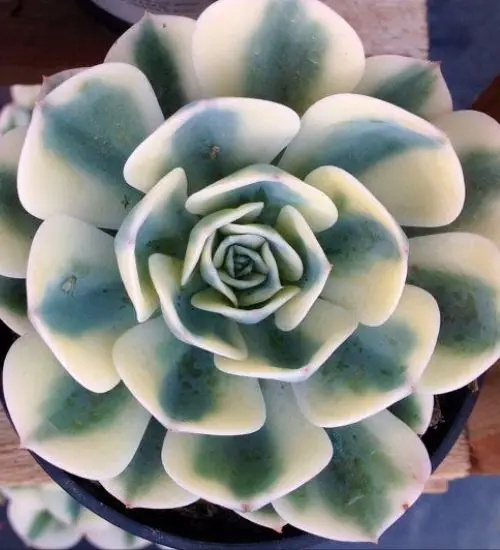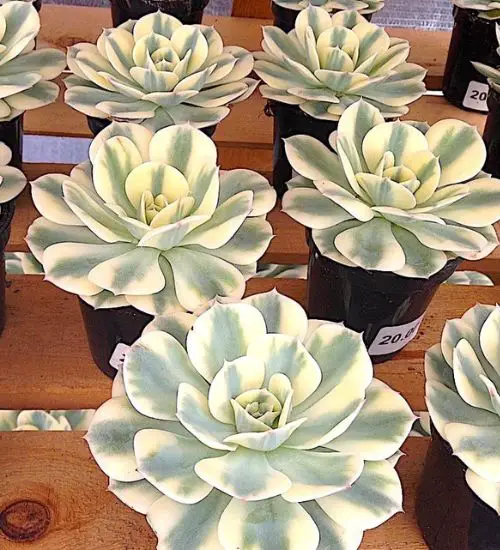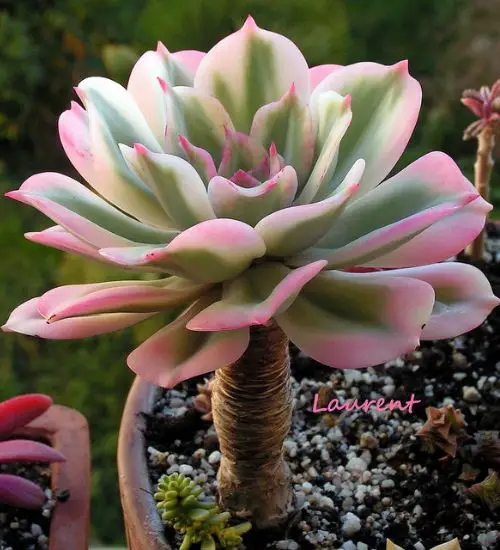Sun: Full sun to light shade
Water: Typical water needs for a succulent
Temperature:
Winter Survival: Not cold hardy
Propagation: offsets, seeds
Flower: in the summer
Flower Type: Red, Yellow
Toxic: Generally non-toxic to humans and animals
Dormant: summer
Space Requirement: Indoors & Outdoors
Common Problems: No major pests, Plants may rot if overwatered
Where to buy Echeveria imbricata ‘Variegata’?
Basc Care for Echeveria imbricata ‘Variegata’
Watering
Watering for Echeveria imbricata ‘Variegata’ is a simple task. It requires Typical water needs for a succulent.
What you need to remember is that this type of succulents needs to be watered for every 2 weeks
Fertilizing
Only feed this succulent during its active growing seasons which means winter. Use the right fertilizer applied in the right amounts. Applying half-strength balanced fertilizer every month or so is recommended for optimal results.
Do not fertilize during summer as the plant is dormant.
Sun & Location Requirements for "Echeveria imbricata ‘Variegata’"
Echeveria imbricata ‘Variegata’ thrives in full sun to light shade. This means that it should be exposed to direct sunlight for most of the day for optimal growth and health. Make sure your succulent is placed in a spot where it will receive no more than 5 hours of shade each day.
As per this succulent profile, it is only able to stay healthy when the environment temperature is above the range of %temperature_label%.
In order to protect Echeveria imbricata ‘Variegata’ from freezing temperatures, it is important to provide adequate insulation and drainage. A layer of mulch or gravel will help protect the roots by keeping them warm during cold weather. In addition, protection from wind and sun exposure can help reduce the chances of frost damage.
Any succulents in the group will need a medium space to grow. You can place your pot at your table or window. Since this plant needs more space than mini succulents, you should consider do not plant them together with other succulents/plants.
Echeveria imbricata ‘Variegata’ also benefits from some indirect light throughout the day as well, so make sure you give it enough space to soak up light without becoming too exposed to heat.
Propagation
One way to propagate Echeveria imbricata ‘Variegata’ is by offsets. Taking an offset from the mother plant and potting it into soil will give you a brand new succulent with minimal effort.
Echeveria imbricata ‘Variegata’ propagates easily from seeds, however it's important to look for healthy ones which are plump, dark in color and slightly sticky when touched. To start the propagation process, mix a soil mixture with well-draining potting mix then sow the seeds evenly and press them lightly into the surface. Finally, water the soil using a spray bottle and place it in bright but indirect light to ensure germination.
Toxicity

Echeveria imbricata ‘Variegata’ is generally non-toxic to humans and animals. However, the plant may contain certain toxins which can cause mild skin irritation if it is ingested or comes in contact with skin. Therefore, it is important to keep the plant away from children and pets for safety reasons.
Pests and Diseases
Echeveria imbricata ‘Variegata’ is not affected too much by common pests and diseases like most of the other succulents.


